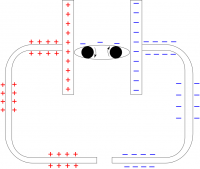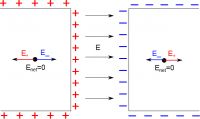This is an old revision of the document!
Connecting a Circuit: Before Steady State
So far, we have talked about how to model batteries and electron current for a steady state current (meaning the wire has been connected for some time). We found that there must be a constant, continuous electric field along the wire that comes from the wire's surface charges to push the electron current through the wire to the battery. But what happens before the steady state current is reached? These notes will go into detail about how a steady current is produced and what happens in the circuit immediately after it is connected.
Before the wires are connected
Suppose we have a battery, with one positive end and one negative end (could be either the chemical model or mechanical model of the battery). At each end, we connect a conductive wire. Before we connect the wires, what would the charge distribution look like along the wire?
The wire that is connected to the negative end of the battery would have a negative distribution of charge because the excess electrons would be able to spread along the length of the wire. Since the wire is a conductor, those excess charges would spread out along the surface of the wire, leaving the interior of the wire with a net electric field equal to zero. A similar process would occur for the wire connected to the positive end of the battery. An approximate charge distribution is shown in the figure, ignoring the exact details of the charge distribution.
If we zoom in on the gap between the wires, We can see an electric field at the end of the wires; however that electric field is cancelled out by the electric field from the wire across the gap. So even in the ends of the wires, the net electric field is zero.

